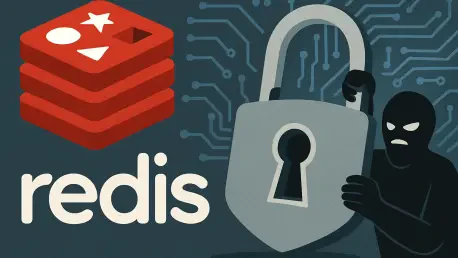Imagine a widely trusted database platform, used in nearly 75% of cloud environments, suddenly revealing a critical security flaw that has gone undetected for over a decade, sending shockwaves through the tech community. This is the alarming reality with Redis, an in-memory database system integral to countless applications. A newly discovered vulnerability, identified as CVE-2025-49844 and nicknamed RediShell, has earned a maximum severity score of 10.0 on the Common Vulnerability Scoring System (CVSS). Residing in Redis’s embedded Lua scripting engine, this use-after-free issue allows authenticated attackers to upload malicious scripts, bypass security sandboxes, and execute arbitrary code on host systems. The potential fallout is severe, ranging from deploying reverse shells for persistent access to stealing sensitive credentials or installing malware. This revelation underscores a pressing need to examine the scope of this threat and the urgency of protective measures in an era where cyber risks are ever-evolving.
Unpacking the Scale of Exposure
The sheer scale of exposure tied to the RediShell flaw is staggering, amplifying the urgency for immediate action. Research from cloud security experts indicates that approximately 330,000 Redis instances are accessible online, with around 60,000 of these lacking any form of authentication. Such a significant number of unprotected servers presents a ripe opportunity for remote exploitation, especially when poor configuration practices are factored in. Attackers could easily leverage this vulnerability to gain unauthorized access, move laterally within networks, or deploy harmful software like cryptocurrency miners. Redis, in collaboration with security researchers, disclosed this critical issue on October 3 and swiftly released patches for multiple versions, including both open-source and commercial editions. Administrators face immense pressure to apply these updates without delay, as the combination of public exposure and inadequate security protocols heightens the risk of widespread compromise in cloud environments globally.
Strategies for Mitigation and Future Security
Addressing the RediShell vulnerability demanded a robust response, and the steps taken reflected a commitment to safeguarding systems. Beyond the immediate patches rolled out across various Redis versions, a comprehensive set of protective measures was recommended to fortify defenses. These included enabling authentication to prevent unauthorized access, restricting connections to trusted networks, and disabling Lua scripting if not required for operations. Additional safeguards like running Redis as a non-root user, implementing firewalls, and using Virtual Private Clouds (VPCs) were advised to minimize the attack surface. Monitoring logs for suspicious activity and setting up alerts also emerged as critical tactics to detect potential threats early. Looking back, the urgency to patch systems and adopt these stringent controls was evident, given Redis’s history as a frequent target for malware and ransomware attacks. The response to this flaw served as a reminder of the ongoing need for vigilance, rapid updates, and layered security practices to protect against evolving cyber threats in widely used platforms.









